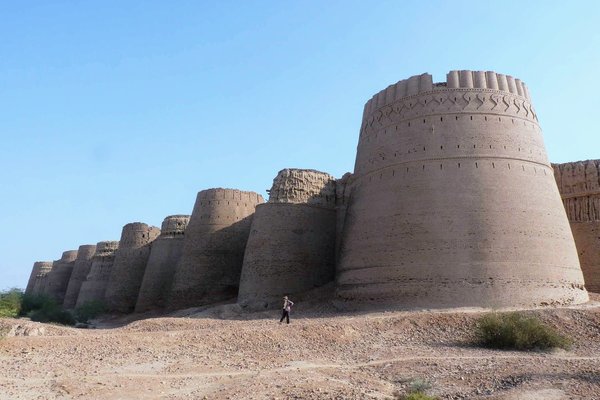Pakistan
Derawar and the Desert Forts of Cholistan
The Desert Forts of Cholistan are a serial proposal of up to a dozen medieval forts in south-eastern Pakistan, of which Derawan Fort is the best known and best preserved. This fortress network served to protect the caravan routes through the Cholistan desert. Derawar Fort is a large square fortress with a perimeter of 1500 metres. It has forty massive bastions with a height up to thirty metres.
Site Info
Official Information
- Full Name
- Derawar and the Desert Forts of Cholistan (ID: 6108)
- Country
- Pakistan
- Status
-
On tentative list 2016
Site history
History of Derawar and the Desert Forts of Cholistan
- 2016: Added to Tentative List
- Added to tentative list
- Type
- Cultural
- Criteria
Links
- UNESCO
- whc.unesco.org
All Links
UNESCO.org
- whc.unesco.org — whc.unesco.org
Community Information
- Community Category
- Secular structure: Military and Fortifications
Travel Information
Recent Connections
News
No news.
Recent Visitors
Visitors of Derawar and the Desert Forts of Cholistan
Community Reviews
Show full reviewsEls Slots
Derawar and the Desert Forts of Cholistan
Derawar and the Desert Forts of Cholistan (On tentative list)

The Desert Forts of Cholistan are a fairly recent addition to Pakistan’s Tentative List, so its potential OUV is better described than that of the earlier ones. The forts were built to enable and protect trade caravan routes and safeguard scarce water resources in the Cholistan desert, which is the western part of the Thar desert. The tentative site is identified as a Silk Road gap as it represents the 'transport' side of the Route instead of its outcomes.
I only visited Derawar Fort, the best-known and most iconic of these Desert Forts. Its perfect row of bastions was awarded with a Google Doodle already. This fort doesn’t lie deep into the desert: while driving up there (on a paved road), we saw sand to the left of the road only for the final kilometers and irrigated fields to the right. It’s also surrounded by a village.
Derawar Fort was built in the 9th century AD by a Hindu Rajput ruler, but its current form dates from the 18th century when it was used by the Muslim Nawabs of Bahawalpur. The exterior, with 40 bastions and impressively high walls, is the best-preserved part. It consists of clay bricks put together in decorative patterns. The last restorations were done in 2019 by Pakistani authorities.
The interior courtyard is the same mess as you’ll see at Lahore Fort or Rohtas Fort – everything is left to crumble, attracting graffiti and garbage. Only the prisoners’ cells and the hanging tower …
Keep reading 0 comments
